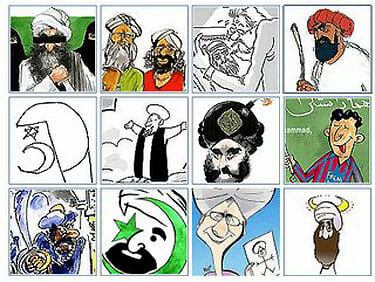Art Book Omits Any Pictures of Art
The producers of a book about a series of famous works of art decided unanimously that it was unnecessary to include any pictures of the works of art being discussed.
[The pictures are] freely available on the Internet and can be accurately described in words, Mr. Donatich said, so reprinting them could be interpreted easily as gratuitous.
Can you imagine this being said about a book on, say, Seurat? Could you describe in words adequately the visual impact of Pissaro, or how it differed from Monet? No? Pictures are a visual medium - I would argue that they are failures if they can be adequately and completely described in words alone.
Of course, the quote above is not about an art book, it is a book from Yale University Press about the group of the 12 Mohamed cartoons drawn by that Danish cartoonist. Someone (actually an entire publishing staff) actually thinks it is a good idea to write an entire book about a set of visual media without reproducing the visual media in the book. Incredible
Ironically, the cartoons are freely available on the Internet ONLY because some Internet site proprietors have more intestinal fortitude than Yale. If everyone took the same stance as Yale, they would not be freely available. And since most of the major media made the same editorial choice not to publish the cartoons at the time of the controversy, the likelihood that a reader has not actually seen the pictures is much higher than, say, for a Seurat book. In this sense, Yale had a greater, not a lesser, obligation to publish the cartoons in the book.
Besides, to see the cartoons is to say, "WTF is all the fuss about." I mean they are bland, bland, bland by the scale of either American or European political cartooning.

Seriously, the only reasons someone would want to not publish these cartoons is to help hide just what an astounding over-reaction it was to make much of a fuss over them in the first place. Seriously, these things are the Emperor's new clothes, except that a few folks calling them out for being naked still haven't stopped a majority of the intelligentsia from continuing to pretend.
This is also ironic given the really, really low bar Yale has set for art in the past.
Actually, the Shvarts' abortions were a pretty great piece of performance art (she stirred up a media storm of controversy and the art department would *not* let her graduate based on her masterpiece (by my definition, being banned is a great indication of having done something worth attention)). Quote from Wikipedia: "Subsequent testing revealed that no human blood was found in Shvarts' project, indicating that it was not the product of induced miscarriage.[8] Shvarts subsequently submitted a different senior project to her department and graduated from Yale University in May, 2008."
Kudos on calling Yale on not publishing those Cartoons. That's a meek copout reeking of conformity in a place that ought to promote the freedom of expression.
You're basically right, but this isn't:
"If everyone took the same stance as Yale, they would not be freely available."
If everyone took the same stance as Yale, Yale would have decided to publish them (assuming Yale is being honest). This sentence doesn't make sense; everyone can't take the same stance as Yale, because the minute everyone does, everyone else decides to publish them -- infinite loop, if you get my drift.
The most ironic thing about all this, which I haven't really seen mentioned, is the religious background here. The point of not depicting Mohamed was to ensure that he did not turn into an idol. Instead, they idolized his non-representation, which essentially accomplishes exactly what they tried to prevent. The zealous attacks on the cartoonists and the publishers only shows how hypocritical these people are.
But if the images were covered with rotting menstrual fluids and wrapped in plastic it would have been just fine at Yale.
What they should do is have blank pages throughout the text where users can download and paste in the appropriate image--similar to the kids books they have for visiting the National Parks.
There is a second irony in not publishing the art. The controversy and stir that was created gave many zeolous religious leaders intent on stirring things up the opportunity to add some really crude and tasteless images to this fairly tame set of 12. By not including the images, Yale is facilitating more of the same.